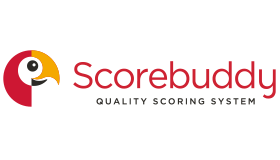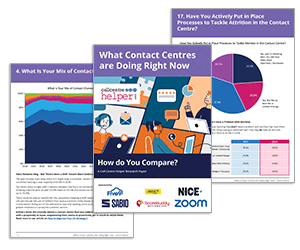This blog summarises the key points from a recent article from David McGeough at Scorebuddy, where he explores 10 key call centre metrics that can help you measure and improve your customer experience effectively.
Have you ever considered what it’s really like for customers to engage with your call centre? Your customer experience (CX) plays a crucial role in shaping retention rates, brand perception, revenue growth, and overall reputation.
Tracking and analysing the right call centre metrics is essential to understanding what’s working, what’s not, and how customers truly feel. In fact, 77% of consumers value CX as much as product and price — neglecting it can risk losing them.
Why Tracking Call Centre Customer Experience Is Crucial
Your contact centre plays a pivotal role in shaping customer perceptions. Every interaction your agents have with customers directly influences how your brand is viewed. A single poor experience can quickly push customers away, while positive interactions build loyalty and trust.
In fact, Salesforce data reveals that 80% of customers believe a company’s experience is just as important as its products or services.
By actively tracking and improving customer experience (CX), you can:
- Strengthen customer relationships
- Increase customer retention
- Improve brand reputation
- Drive positive word-of-mouth
Without proper insight into these interactions, businesses risk losing control of customer sentiment – which can ultimately impact revenue.
But which metrics should you prioritise to gain meaningful insights? Let’s explore the most important ones.
Top 10 Call Centre Metrics for Measuring CX
1. Customer Satisfaction (CSAT) Score
What Is CSAT?
CSAT stands for Customer Satisfaction Score. It’s a key performance metric used to measure how satisfied customers are with a company’s products, services, or experiences. Typically, CSAT is measured through surveys where customers rate their satisfaction on a scale, often from 1 to 5 or 1 to 10.
For example, a typical CSAT survey question might be, “How satisfied were you with your experience today?” – [ ] Very Unsatisfied [ ] Unsatisfied [ ] Neutral [ ] Satisfied [ ] Very Satisfied
Ways to Improve CSAT:
- Keep surveys short and send them immediately after the interaction.
- Include open-ended questions to gather deeper insights.
- Use AI tools to analyse qualitative feedback for trends.
- Implement alerts for negative responses so your team can address issues promptly.
2. Net Promoter Score (NPS)
What Is NPS?
NPS stands for Net Promoter Score and is a powerful tool for measuring customer loyalty and predicting future business growth. It’s based on one simple yet effective question:
“How likely are you to recommend our business to a friend or colleague?”
Customers respond on a scale from 0 to 10:
- Promoters (9-10): Loyal enthusiasts who actively recommend your brand and fuel growth.
- Passives (7-8): Satisfied but unenthusiastic customers who may switch to competitors.
- Detractors (0-6): Unhappy customers who may damage your brand through negative word-of-mouth.
To calculate NPS, subtract the percentage of detractors from the percentage of promoters.
Ways to Improve CSAT:
- Track NPS trends over time, not just individual scores.
- Follow up with detractors to understand their concerns.
- Segment feedback by issue type for targeted improvements.
3. First Contact Resolution (FCR)
What Is FCR?
FCR, or First Contact Resolution, is a key customer service metric that evaluates how effectively a company resolves customer inquiries, issues, or requests during the initial interaction – without requiring additional follow-ups.
A high FCR rate indicates that customers are getting their issues resolved quickly and efficiently, which often leads to improved customer satisfaction, increased loyalty, and reduced operational costs.
Organisations track FCR closely as it reflects both the quality of their support processes and the effectiveness of their agents.
Ways to Improve FCR:
- Track unresolved issues in your CRM to identify patterns.
- Ensure agents are well-trained in handling common issues.
- Implement knowledge bases to support agents during complex interactions.
4. Customer Effort Score (CES)
What Is CES?
CES stands for Customer Effort Score. It’s a customer service metric that measures how easy it was for a customer to get their issue resolved, make a purchase, or complete a desired action.
Customers are typically asked a question like:
- “How easy was it to resolve your issue?”
They respond on a scale, often from 1 (Very Difficult) to 7 (Very Easy), or sometimes on a scale of 1-5 or “Strongly Disagree” to “Strongly Agree”.
Ways to Improve CES:
- Ask CES questions in post-interaction surveys.
- Identify common pain points like long hold times or transfers.
- Use speech analytics to pinpoint friction points in conversations.
5. Customer Sentiment Analysis
What Is Customer Sentiment?
Customer sentiment refers to the overall feelings, attitudes, and perceptions customers have toward a company, brand, or product, based on their experiences and interactions.
It’s often measured through surveys, social media monitoring, and feedback analysis, providing valuable insights into how customers feel – whether positive, negative, or neutral – about a business.
Understanding customer sentiment helps businesses identify strengths, address weaknesses, and improve overall customer experience.
Ways to Improve Customer Sentiment:
- Use real-time sentiment analysis to spot issues as they arise.
- Compare sentiment trends with CSAT and NPS for deeper insights.
- Coach agents on managing difficult conversations.
6. Average Handle Time (AHT)
What Is AHT?
AHT stands for Average Handle Time and is a key metric used in customer service to measure the average duration it takes to resolve a customer issue.
It includes the time spent talking to the customer, as well as any post-interaction tasks like follow-up or documentation. AHT is important for assessing efficiency in handling customer inquiries, though it’s important to balance speed with quality to ensure a positive customer experience.
Ways to Improve AHT:
- Balance speed with service quality in coaching.
- Use AI tools to automate after-call summaries.
- Train agents to resolve issues efficiently without rushing.
7. Call Abandonment Rate
What Is Call Abandonment Rate?
Call Abandonment Rate is the percentage of calls that customers hang up before reaching a customer service representative. It’s a key metric used in call centres to measure customer frustration or dissatisfaction with wait times.
A high call abandonment rate may indicate long wait times, poor service availability, or inefficient call routing, signalling areas where the business needs to improve in order to retain customers and provide better service.
Ways to Reduce Call Abandonment:
- Optimise staffing during peak hours.
- Introduce call back options to reduce hold times.
- Identify and improve pain points in your IVR system.
8. Quality Assurance (QA) Scores
What Are QA Scores?
QA Scores (Quality Assurance Scores) are metrics used to evaluate the performance and quality of customer service interactions, typically through call centres, live chat, or email support.
QA scores are determined by assessing factors such as how well the agent followed procedures, the accuracy of information provided, the tone and professionalism of the interaction, and how effectively the customer’s issue was resolved.
These scores help businesses monitor agent performance, maintain service standards, and identify areas for training and improvement.
Ways to Improve QA Scores:
- Use AI-powered QA tools for broader evaluation coverage.
- Regularly review QA scorecards for consistency.
- Link QA insights to customer feedback metrics like CSAT and NPS.
9. Omnichannel Experience Metrics
What Are Omnichannel CX Metrics?
Omnichannel CX (Customer Experience) Metrics are measurements that assess the consistency and quality of customer interactions across multiple communication channels, such as phone, email, live chat, social media, and in-person.
These metrics help businesses understand how seamless and integrated the customer experience is across all touchpoints.
Ways to Improve Omnichannel CX:
- Unify customer data across all channels for a seamless experience.
- Monitor channel-specific pain points.
- Ensure agents have visibility into previous interactions across channels.
10. Customer Feedback
What Is Customer Feedback?
Customer feedback refers to the opinions, comments, and suggestions provided by customers about their experiences with a product, service, or brand.
Customer feedback helps businesses understand customer satisfaction, identify areas for improvement, and make data-driven decisions to enhance products, services, and overall customer experience.
Ways to Collect and Use Customer Feedback Effectively:
- Create dedicated teams to review and act on feedback.
- Regularly audit CX metrics to identify patterns.
- Map customer journeys to identify friction points.
Turning Insights Into Action
Tracking these metrics provides valuable insights, but meaningful change comes from acting on them.
- Use data trends to refine processes.
- Address recurring issues to reduce friction.
- Continuously coach agents to improve performance.
Combining these insights with robust QA processes will give you a deeper understanding of what’s driving CX success – and where improvements are needed.
By focusing on both quantitative metrics and qualitative insights, you’ll create better experiences that keep customers happy, engaged, and loyal.
For more information about Scorebuddy - visit the Scorebuddy Website
Call Centre Helper is not responsible for the content of these guest blog posts. The opinions expressed in this article are those of the author, and do not necessarily reflect those of Call Centre Helper.
Author: Scorebuddy
Reviewed by: Megan Jones
Published On: 8th Apr 2025
Read more about - Guest Blogs, David McGeough, Scorebuddy






 Scorebuddy is quality assurance solution for scoring customer service calls, emails and web chat. It is a dedicated, stand-alone staff scoring system based in the cloud, requiring no integration.
Scorebuddy is quality assurance solution for scoring customer service calls, emails and web chat. It is a dedicated, stand-alone staff scoring system based in the cloud, requiring no integration. 









